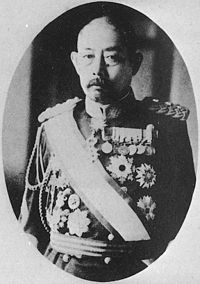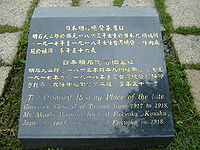- Akashi Motojiro
-
Baron Akashi Motojirō
Japanese General Akashi MotojirōBorn 1 September 1864
Fukuoka, Chikuzen Province, JapanDied October 26, 1919 (aged 55)
Fukuoka, JapanAllegiance Empire of Japan Service/branch  Imperial Japanese Army
Imperial Japanese ArmyYears of service 1889-1919 Rank general Battles/wars First Sino-Japanese War
Russo-Japanese WarOther work Governor-General of Taiwan In this Japanese name, the family name is "Akashi".Baron Akashi Motojirō (明石 元二郎, 1 September 1864 – 26 October 1919) was a general in the Imperial Japanese Army and the 7th Governor-General of Taiwan from 6 June 1918 to 26 October 1919.
Contents
Early life and career
A native of Fukuoka and a graduate of the 1889 class of the Imperial Japanese Army Academy, Akashi was nominally under the Imperial Guard Division attached to the staff of General Kawakami Sōroku during the First Sino-Japanese War. His primary duty was information gathering, and in that capacity he traveled extensively around the Liaodong Peninsula and northern China, Taiwan and Annam. Towards the end of the war, he was promoted to major.
After the Sino-Japanese War, he was dispatched as a military observer to the Philippines during the Spanish-American War, and during the Boxer Rebellion, he was stationed out of Tianjin in northern China. Around this time, he was promoted to lieutenant colonel.
A Spy during the Russo-Japanese War
Akashi was sent as an itinerant military attaché in Europe at the end of 1900, visiting Germany, Switzerland, Sweden, staying in France in 1901, and moving to Saint Petersburg, Russia in 1902. As a member of the Japanese Secret Intelligence Services, Akashi was involved in setting up an intricate espionage network in all major European cities, using specially trained operatives under various covers, members of locally-based Japanese merchants and workers, and local people either sympathetic to Japan, or willing to be cooperative for a price.
In the period of growing tensions before the outbreak of the Russo-Japanese War, Akashi had a discretionary budget of 1 million yen (an incredible sum of money in contemporary terms) to gather information on Russian troop movements and naval developments. While based at Saint Petersburg, he recruited the famous spy Sidney Reilly and sent him to Port Arthur, to gather information from within the Russian stronghold on its defenses. After the start of the war, he used his contacts and network to seek out and to provide monetary and weaponry support to revolutionary forces attempting to overthrow the Romanov dynasty.
Akashi was also known for his talents as a poet and as a painter, interests that he shared with fellow spy and close friend General Fukushima Yasumasa. It was also a shared interest in poetry and painting that enabled him to cultivate Sidney Reilly into working for the Japanese.[1]
Narrowly escaping capture and assassination by the Ochrana several times even before the start of the war, Akashi relocated to Helsinki in late 1904, although he traveled extensively to Stockholm, Warsaw, Geneva, Lisbon, Paris, Rome, Copenhagen, Zurich and even Irkutsk. Akashi helped funnel funds and arms to selected groups of Russian anarchists, the secessionists in Finland and Poland, and disaffected Moslem groups in the Crimea and Russian Turkestan. Akashi is also known to have met with Konni Zilliacus in Stockholm and Lenin, then in exile in Switzerland. It is widely believed in Japan that Akashi was behind the assassination of Russian Interior Minister Vyacheslav von Plehve (whom many in Japan held responsible for the war), the Bloody Sunday Uprising and the Potemkin Mutiny. General Yamagata Aritomo reported to Emperor Meiji that Colonel Akashi was worth "more than 10 divisions of troops in Manchuria" towards Japan winning the war. Akashi was promoted to colonel at age 40.
Korea under Japanese rule
In 1905, just prior to the end of the war, he was recalled to Japan, divorced his wife, remarried, and joined the ground forces in Korea as a major general in charge of the 14th Infantry Division
Although Akashi is known to have received support from his close contacts within the Kokuryukai secret society, and although he certainly shared in many of their political goals, his name does not appear on their membership lists and it is mostly likely that he was never actually a member.
After the war, he remained in Korea with General Terauchi Masatake, where he organized the military police organization. He was promoted to lieutenant general at the age of 49.
As Governor-General of Taiwan
In 1918, Akashi was promoted to general and appointed by Prime Minister Terauchi as the Governor-General of Taiwan. He also received the title of danshaku (baron) under the kazoku peerage system. During his brief tenure, Akashi devoted significant efforts to improving the infrastructure and economy of Taiwan, and is especially remembered for his electrification projects and the creation of the Taiwan Power Company, and for planning the Sun Moon Lake hydroelectric power plant. The "lake" was originally a swamp. Akashi built concrete pipes to introduce water from the nearby Muddy Water River, and built a huge dam with water siphoned from the river. The dam and its surrounding area, known as "Sun Moon Lake" today, has given Taiwanese and foreign visitors quite a bit of romantic memories. (The Chinese government, without consent of the Taiwanese, even calls it one of China's top ten sceneries.) Akashi's greatest contribution to Taiwan, however, was the construction of "Ka-Nan Irrigation System," which totals 16,000 miles (26,000 km) long, several times the length of China's "Great Wall." It cost the Taiwan government at that time more than one year's budget. The Japanese Imperial Diet, had to pass a special law for the extra appropriation of 26 million yen in 1918, equivalent to roughly 2 billion today's U.S. dollars, which was a big burden on Japan's finance at that time, although it would be impossible to build such a dam today with the relatively paltry 2 billion U.S. dollars.[2]
Death and burial
Akashi fell ill and died a little over a year after taking office while visiting his home in Fukuoka becoming the only Governor-General of Taiwan to die in office. In his will, Akashi expressed his desire to be buried in Taiwan to "serve as a national guardian, and a guardian spirit for the people of Taiwan". Akashi was buried at a cemetery in Taihoku (modern day Taipei City), becoming the only Japanese Governor-General to be buried in Taiwan. The Taiwanese donated money equivalent to roughly three million modern day U.S. dollars for construction of a memorial, and support fund for his family, because Akashi himself was too clean to leave anything behind. His remains were exhumed in 1999 and re-interred at the Fuyin Mountain Christian Cemetery in Sanzhi Township, Taipei County (now New Taipei City).[2] Akashi's death has spawned a massive number of conspiracy theories.
The flamboyant exploits (both real and imagined) of "Colonel Akashi" have been the subject of countless novels, manga, movies and documentary programs in Japan, where he has been dubbed the "Japanese James Bond".
See also
References
Journal
- "Rakka ryusui [Colonel Akashi's Report on His Secret Cooperation with the Russian Revolutionary Parties during the Russo-Japanese War]" Studia Historica (31) 1988 ISSN 0081-6493
Books
- Ching, Leo T.S. (2001). Becoming Japanese: Colonial Taiwan and the Politics of Identity Formation. ISBN 0-520-22553-8: University of California Press.
- Deacon, Richard (1986). A History of the Japanese Secret Service. ISBN 0-425-07458-7: Berkley Publishing Company.
- Lockhart, Robin Bruce (1986). Reilly: Ace of Spies. ISBN 0-88029-072-2: Hippocrene Books.
External links
- National Diet Library. "Akashi Motojirō". Portraits of Modern Historical Figures. http://www.ndl.go.jp/portrait/e/datas/221.html.
- Japan Center for Asian Historical Records. "Akashi Motojirō". Clouds over the Hill and Archives. http://www.jacar.go.jp/english/nichiro/cloud_akashi.htm.
Notes
Japanese Governors-General of Taiwan Kabayama Sukenori • Katsura Tarō • Nogi Maresuke • Kodama Gentarō • Sakuma Samata • Andō Teibi • Akashi Motojirō • Den Kenjirō • Uchida Kakichi • Izawa Takio • Kamiyama Mitsunoshin • Kawamura Takeji • Ishizuka Eizō • Ōta Masahiro • Minami Hiroshi • Nakagawa Kenzō • Kobayashi Seizō • Hasegawa Kiyoshi • Andō RikichiCategories:- Japanese generals
- Kazoku
- People from Fukuoka (city)
- People of the First Sino-Japanese War
- Japanese military personnel of the Russo-Japanese War
- Japanese spies
- People in Meiji period Japan
- Governors-General of Taiwan
- 1864 births
- 1919 deaths
Wikimedia Foundation. 2010.


